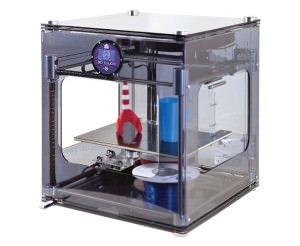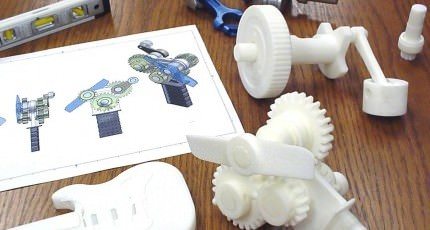Most people are still in discovery mode as to what 3D printing actual means. The innovative technology that is sometimes known as “additive manufacturing” really is less 3D printing and more 3D fabrication. With the price of 3D printers dropping as the technology progresses, the machines are making quite a stir with both private and governmental industries. This week many of the biggest names involved in the future of 3D printing met in New York to talk shop and examine the newest concepts in this emerging applied science.
 A 3D printer works through a sequential layering process to create three dimensional solid objects from digital models. This additive process is different from traditional manufacturing, which uses a subtractive process of machining through the removal of materials with methods like drilling and cutting. Currently, the standard materials used in 3D printing span a variety of plastics and metals, and are capable of producing anything from prototypes to full scale products. The process has been successful in manufacturing and prototyping for industries such as automotive, medical and dental, industrial design, and even jewelry and footwear.
A 3D printer works through a sequential layering process to create three dimensional solid objects from digital models. This additive process is different from traditional manufacturing, which uses a subtractive process of machining through the removal of materials with methods like drilling and cutting. Currently, the standard materials used in 3D printing span a variety of plastics and metals, and are capable of producing anything from prototypes to full scale products. The process has been successful in manufacturing and prototyping for industries such as automotive, medical and dental, industrial design, and even jewelry and footwear.
Video Education | 3D Printing: How it is Changing the World
3D Printing Gets a Boost From the Photon Scanner
The current limitation is the product designer’s ability to create a 3D schematic or plan file. This can involve complicated computer aid design programs that limit who is actually capable of creating a design. A newly innovated 3D photon scanner is helping to increase the user friendliness of the 3D printer. John Breeden discusses the scanner in his article on GCN.com:
“…many CAD suites require intensive training to achieve even marginal proficiency. While many CAD templates exist, the likelihood of finding a template for the exact wrench, handle, gear or tool needed is rather slim. If a specific CAD file doesn’t exist, then it’s up to the operator to become part engineer and part artist to try and put something together.
“The Photon 3D scanner allows anyone to take a physical object and turn it into a digital 3D model on your computer,” said Drew Cox of Matterform. The scanner shoots dual laser lines at an object rotating 360 degrees and takes pictures with a high-definition camera, Cox said. Software then creates the digital 3D model. Depending on the object, a scan can be completed in a little as three minutes.
“Once the file is created, it can be modified, reproduced on a 3D printer to create copies of the original object, used in animations or 3D designs or saved to keep a digital archive,” he said.
The company’s website has pictures of detailed objects that were scanned with the Photon and the resulting CAD files that can be used by any 3D printer. Scans can be made in low or high resolution, depending on how much detail is actually needed for the replication process.
The Photon was successfully crowd-funded, with over $300,000 from donations. The unit itself will go on sale soon for $599.”
Increased Funding for 3D Printer Companies
These exciting developments in 3D printing have been followed by a flood of investor funding. No where is this better exemplified than with the online community and marketplace Shapeways.com. This site provides a platform where designers can not only make and sell their products, but also share ideas and access cutting edge technology. Shapeways is capable of creating high quality 3D prints using over 30 materials through an accessible and affordable process. And with the $30 Million investment from Chris Dixon and VC firm Andreessen Horowitz, the sky is surely the not the limit to what they can accomplish.
Ricardo Bilton goes in depth at VentureBeat.com to discuss what this investment means to 3D printing:
So why 3D printing? And why Shapeways? And why now? Dixon’s reasoning is simple: 3D printing’s moment has come, and Shapeways is leading the charge.
“3D printing is important because so much of what we’ve done over the last 20 years has been moving bits around. Now we’re starting to see tech impact the physical world,” said Dixon, who is joining the Shapeways board of directors.
According to Dixon, Shapeways does three things well: Not only has it created a strong community, but it’s also built a strong service model and factory footprint. (It opened a New York City factory in October) ”It’s like building three different companies at once,” Dixon told me. “We think they’ve executed well on all those things. They’re the clear leader in the space.”
(Sidenote: If you follow Dixon’s blog, it should be clear that he’s been thinking about this stuff for a while. As he noted in a post earlier this month, people tend to be skeptical of new technologies before there are obvious uses for them, and 3D printing is no exception.)
Shapeways’s focus on 3D printing as a service rather than just a technology is also an important. Unlike hardware-focused companies like MakerBot and 3D Systems, Shapeways’s strategy assumes — probably correctly — that people will be more likely to adopt 3D printing if they don’t have to invest in their own printers.
And yet, Shapeways’s take on 3D printing is still faced with a major hurdle — awareness.
“Our challenge now is making sure more people see the use in our service. We want to make this real for people,” Shapeways CEO Peter Weijmarshausen told me. “Making 3D printing accessible is a big challenge,” he said.
“A lot of it is an education thing,” says Chris Dixon. “People are often very surprised by quality of the printed things — but you can’t fully tell by looking at a website. Awareness will take some time.”
Still, despite the challenges facing Shapeways, the company is doing pretty well for itself so far: Weijmarshausen says that Shapeways’s 300,000 users upload 60,000 product designs each month — so the community is certainly there.
Much of that interest certainly ties into the fact that Shapeways is not only helping to make manufacturing local again, but it’s also opening the door for many more designers to make cash off their creations.
“In the same way the Internet unlocked the long tail of publishing, Shapeways is trying to do that with manufacturing,” Chris Dixon said.”































